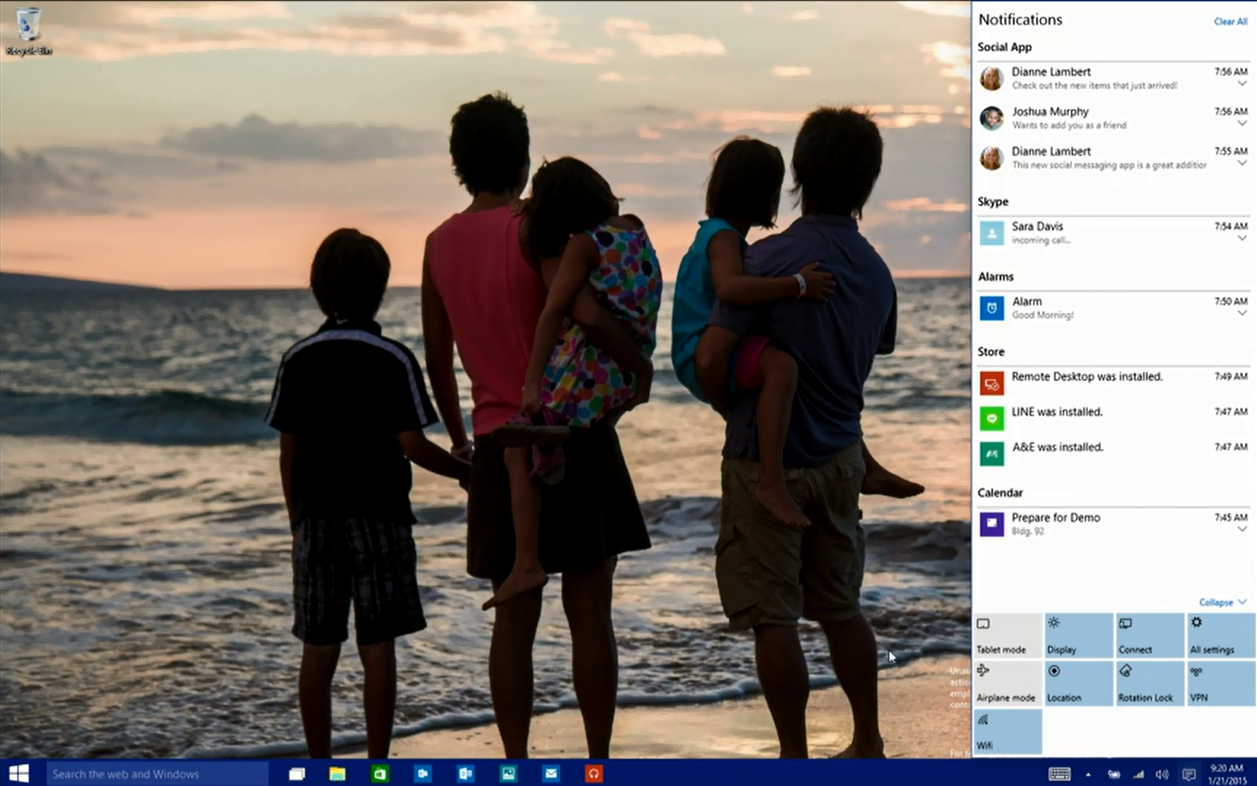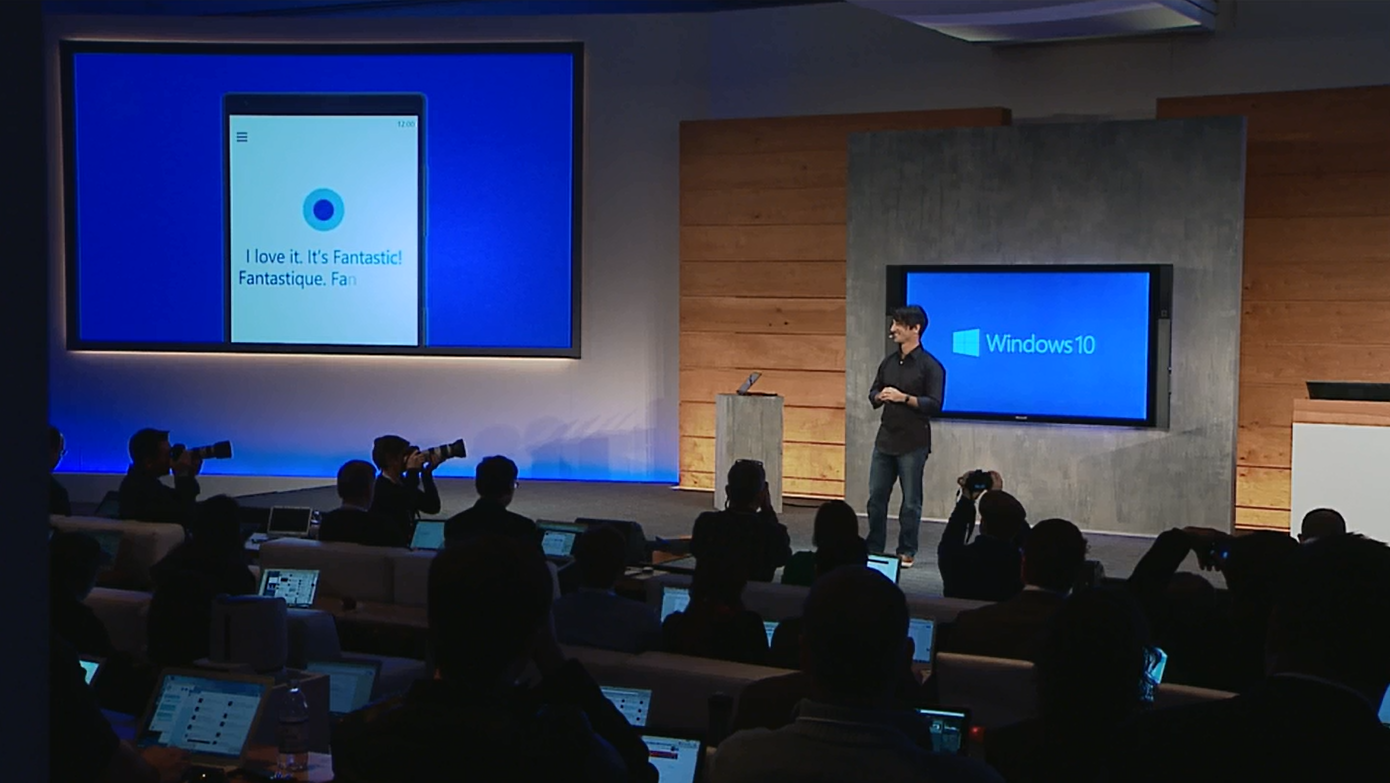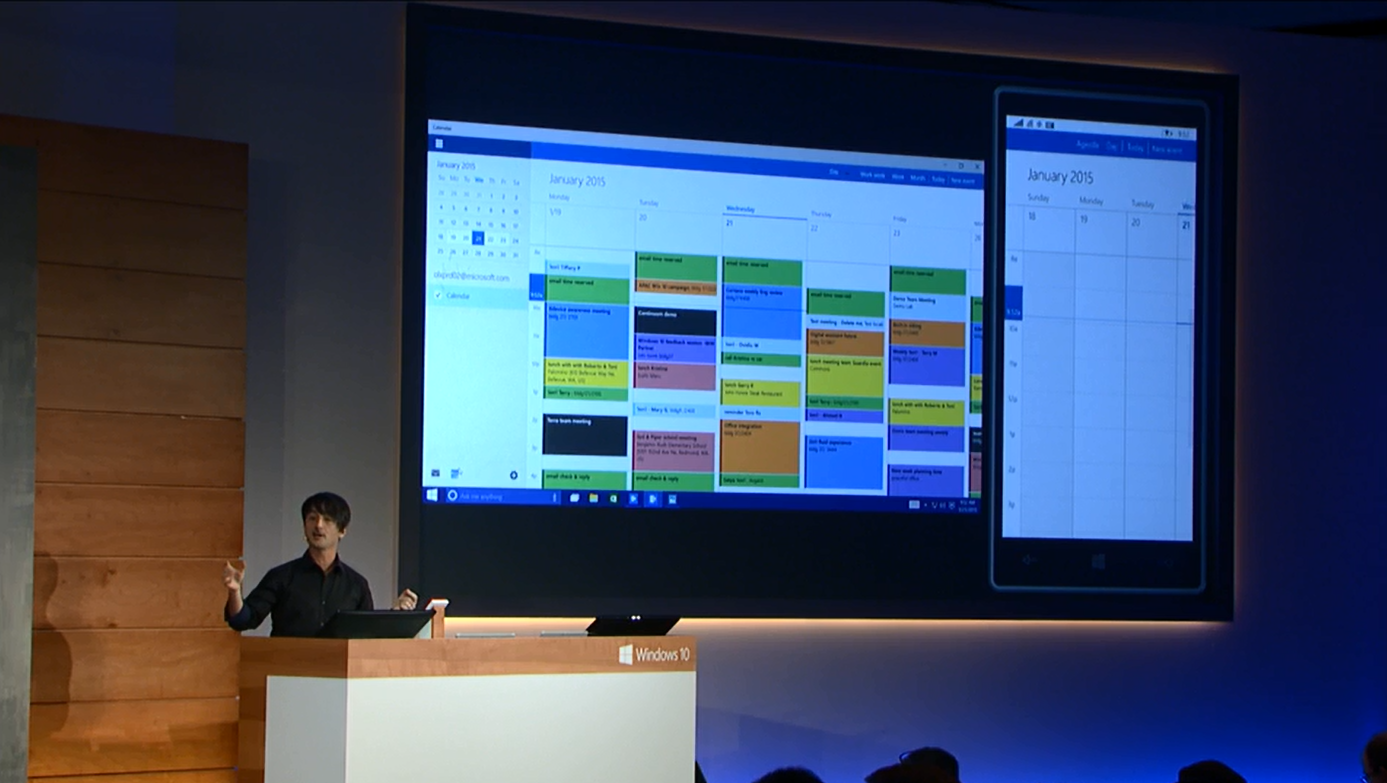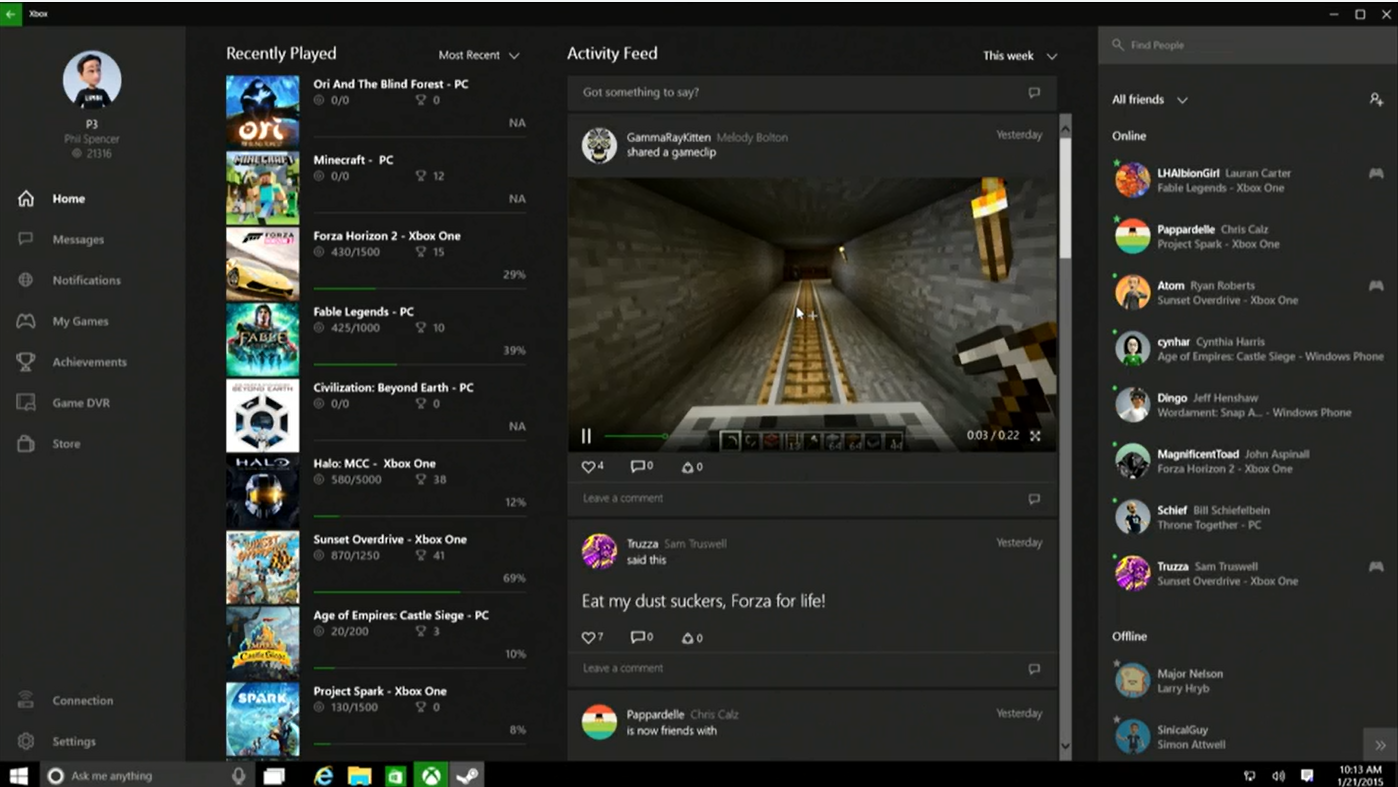Microsoft Reveals Windows 10 Details: Universal Apps, Cortana On All Platforms, Xbox Integration, More
We're still months away from seeing Windows 10 hit the market as a finished product, but at Microsoft's event today, the company showed more of the features that will come with the new operating system.
Microsoft has shifted focus of Windows 10 from merely running independently on the PC to working across a multitude of platforms including 2-in-1s, tablets, and smartphones. (And Xbox One, sort of.) With Windows 10, the company wants to focus on what it calls true "personal computing," where user interaction is easy and seamless whether you're using the PC or a smart portable device.
For those who haven't seen a glimpse of Windows 10 in action, Microsoft's Joe Belfiore gave a quick review of some of the things we already know about Windows 10. For starters, the Start button missing from Windows 8 has finally returned, accompanied with a search bar to its right to easily find documents. Windows 8 fans haven't been left out completely, as the Start menu can expand to a full screen to give it the familiar Windows 8 feel.

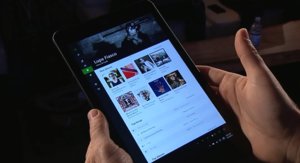
Belfiore also showed off the new system's Continuum feature, which, when installed on a 2-in-1 device like the Surface tablet, will detect when the device is attached to a keyboard or is in tablet mode and will change the interaction mode to suit the presence or lack of a peripheral.
Cortana
Microsoft wanted to make Windows 10 a more personal experience for each user, and adding Cortana is a key way of doing that. Cortana, which initially only existed on Windows 8.1 phones, is coming to Windows 10 on the PC. With multiple voice commands, you can command Cortana to search for files, write and send emails, control music and more.
If voice commands aren't your thing, you can still "talk" to Cortana by typing out commands. Users can still filter Cortana's personal behavior towards the user with Notebook. This shows you what Cortana "knows" about you, and you can manually add or subtract items from it.
In an onstage demo, Belfiore chatted with Cortana, and she was...charming. She sounded like a real person, and she even did funny accents. (She sounded more robotic when he put her to work on later demos.)
Get Tom's Hardware's best news and in-depth reviews, straight to your inbox.
Universal Apps
Microsoft also revealed a whole suite of universal apps that works across all devices. By leveraging OneDrive, users can access apps such as Photos, Videos, Mail, Maps, Messaging and Calendar.
The Photos app now filters through your entire catalog of photos in Collection View and removes duplicates or a series of burst shots to only show the photos that are best. The app also enhances some photos by adding more lighting or removing the red-eye effect on subjects.
The Mail app now allows swipes to the left and right for deleting or flagging certain messages, respectively. Perhaps one of the best examples of Windows 10 working on multiple devices is with the Maps app. You can use the phone on the road as a GPS, but if you run into unexpected traffic, someone can use the PC at home to find an alternate route and send it to your phone. Cortana also plays a role in the Maps app, as she can remember where your car is parked for you when you to go an event.
Office is also added on Windows 10 as a universal app, but most of the innovation for the updated apps are more for mobile and tablet versions. Word, Excel, and PowerPoint show tabs that can be pulled from the bottom of the screen and can change viewing and formatting settings. PowerPoint presentations can be annotated, and new touch controls have been added in Excel.
Xbox: Play With PC Pals
Xbox head Phil Spencer also showed up to demonstrate how gaming works with Windows 10. The Xbox app on the PC ensures that players are always connected to their Xbox One. It features a list of games you own, shows your list of friends, enables messaging and shows an activity feed.
With Windows 10, you can stream your Xbox gameplay onto a PC or any mobile and tablet device that also runs Windows 10. Additionally, PC players can join up with Xbox One players on the same game (such as Fable Legends, which was shown at the event).
Also included in Windows 10 is the Game DVR app, where users can easily capture images and record video of games, even if it's on Steam, and upload it to social media for friends to see.
Spencer also showed off the power of DirectX 12 for Windows 10, which he claimed has the ability to increase performance on CPU-based games by 50 percent when compared to DirectX 11. Because DirectX 12 will also run on tablets and mobile devices, he also said that power consumption has been cut in half to extend the battery life.
Work To Do
With a wide array of features that work on multiple devices and PCs, it's safe to say that Microsoft is throwing everything it can into its new operating system. Windows 10 is an attempt to entice Windows 7 and 8/8.1 customers to upgrade their desktops and laptops, but the value adds on the mobile and gaming sides are also quite compelling.
Microsoft really wants Windows 10 to succeed, and it hopes to do so in part by making it a free upgrade for Windows 7, 8, and 8.1 Phone users during Windows 10's first year.
In the meantime, a new build of Windows 10 will be coming to Windows Insider users next week, and the first mobile build of the new system will arrive in February. There's still a lot of work to be done, as Microsoft will continue to work on Windows 10 for the next three to five months, but today's event has certainly shown Windows fans what direction the company is taking with its new operating system.
Follow Rexly Peñaflorida II @Heirdeux. Follow us @tomshardware, on Facebook and on Google+.
Rexly Peñaflorida is a freelance writer for Tom's Hardware covering topics such as computer hardware, video games, and general technology news.
-
soldier44 I can do without the crapbox integration but Win 10 is shaping up to be what Win 8 was not.Reply -
Onus Ok, voluntary data sharing is nice, but does it otherwise require an active, online connection to perform most tasks? What about Cortana? Is the AI local, or in the Vapor?Reply
-
red77star All what you see won't work unless you run your Windows with Microsoft Account meaning this is all blah.Reply -
red77star Windows 10 is opposite of what I was hoping to be but it looks like this is Windows 8 on steroids heavily using Internet and Cloud. Thanks, but no. In my book Windows 10 is EPIC fail. Looks like Windows 7 is the last OS on my machine before switching to Linux or some other alternative.Reply -
Onus If it has to be online for these functions to work, then it is not a Personal Computer, it is a terminal logged in to someone else's system. No thanks.Reply
-
game junky I think Microsoft is on a tick tock schedule like Intel - seems like Vista was a good concept with bad implementation due to glitches and Windows 7 finished Vista's thought. Windows 8 was a good concept with bad implementation due to being a harsh departure from it's predecessor with plenty of glitches, 8.1 patched some of the glitches but it still feels like it's intended for touch-screen devices only but Windows 10 feels like it's here to take the things people loved about Windows 7 for desktops and all of the things that touch-screen users loved about Windows 8 and married the two together. We will have to wait and see how Continuum, Spartan and some of the nuanced features works when deployed but so far it looks like a winner. It definitely looks to be worth the price of free for Win7/8 users but it might be worth waiting a few weeks to get a couple of patches deployedReply -
red77star Of course you have to be online with Microsoft Account. It is the way it works in Windows Phone. For example Cortana is useless without Internet because she uses Bing Engine to get information and in my personal opinion useless. Once you remove and disable all this cloud stuff you are left with less than Windows 7 including crippled start menu. It is very disappointing presentation by Microsoft. It seems they run out of ideas and started talking about things like holograph just to fill dedicated time for it. In the first technical preview I haven't seen anything useful for business even less now. I don't see a company with 100s of computers upgrading to Windows 10 so they can have Cortana no one is going to use. Microsoft offer of 1 year time period to do free upgrade is rather cheap way of avoiding failure with Windows 10. Even if it was free for 10 years, it is not going to touch my hard drive.Reply -
back_by_demand Red77star, do you seriously think anyone in Amish country is going to use this? Go defect to Linux whilst you await the loss of worldwide always on high speed internet that the rest of the planet enjoys. I could give a damn about people without internet, if they don't then why even own a PC?Reply -
red77star @back_by_demand Difference between people in Amish country is that they have a brain and they know to judge and decide whether something is bad or good unlike your the rest of the planet which goes and gets anything even if it's really worthless as long as it has label FREE on it. Typical for some countries :)Reply
